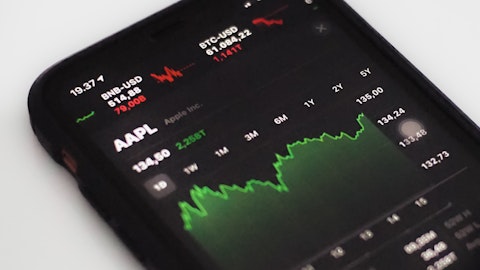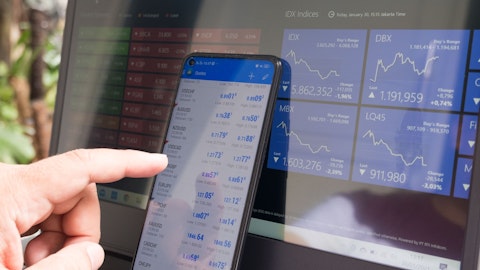Operator: Thank you. And one moment for our next question. And our next question comes from a line of Youssef Squali with Truist. Your line is open. Please go ahead.
Youssef Squali: Hi, guys. Thank you for taking the question. So, I have two here. Just going back to the E-commerce. comments you guys have? I know, you have a new Global Head of that Division, John, just joined recently. Can you maybe be a little more prescriptive in how — what you’re doing to revenue growth there? Clearly, that’s still the biggest piece of the business. And for it to be still down year-on-year is obviously waiting on the whole business. And just kind of how do you think about, how long will it take you feel for us to start seeing maybe positive growth there? And then, back to this AI relationships, can you help us maybe understand how the money flows from deals like OpenAI or Meta, for instance, beyond just the upfront piece, I think Jarrod, you talked about the residual annual revenue there.
Is it based on usage of just continual training of the AI? Or is it based on literally the sale of AI created images, even on third-party sites, leveraging your contents through DALL-E 2 or something like that? Just trying to get a better feel, better understand how the money flows there.
Paul Hennessy: Great. Youssef, I’ll start and then Jarrod can answer your second part question. Hopefully what you’re seeing and it’s very apparent of what we’re doing with E-commerce is we’re getting very, very busy. We are focused on everything from process improvement, product development, tool set delivery for our customers, additional content to lift conversion, and we’re bringing in as we mentioned, more resources to focus on a very strategic part of our business called E-commerce. And I’d say at the same time, we’re laser like focused on being customer centric, so that we’re listening to exactly what our customers needs, building products and services for them and bringing content to bear, so that they can find what they’re looking for and action their business objectives.
So, we’re going to continue to do that. We’ve had a history of doing that. It’s kind of in the DNA. And we’re going to continue to focus our business on that. We’ve also aligned our entire workforce to be very, very strategic on the work that we do. So, we expect to be better executors as we move forward. And you asked about the win in this market with the current backdrop that we’re operating. I can tell you that by June 1 or September 1, there’s going to be a magic event that suddenly E-commerce is going to magically start growing at the rates that we would be excited about. But what I can tell you is, we’ve gotten a lot of minds and hands working on that opportunity. And we’re feeling pretty good about our chances of strong execution there.
And that’s reflected in our guidance. And as Jarrod said, we believe that there’s some potential upside to that guidance, because of the things we did put in and we didn’t put in.
Jarrod Yahes: And Youssef, to the second part of your question just on the money flow is pertaining to our Computer Vision partnerships. Ultimately, we have a massive pool of content and metadata. And when our partners train their AI machine learning models using our metadata, as we confer that data, that is used for model training, and the money would flow. We would build an invoice of those clients, they would pay us. We also receive 30 million to 40 million new content assets each and every year. And so, it is imperative to continue to train AI and machine learning models. And so that’s an extremely valuable source of incremental metadata for our partners. And so, effectively, they’re contracting for a long-term period to continue to ingest and pay for that metadata and that content.
We have typically leverage those partnerships to also get some access to some technology, which we’ve done in the case of an LG or an OpenAI. And we think that’s an intrinsic part of us working collaboratively with our strategic partners. But what we haven’t done thus far as we don’t have effectively a Rev share on the end products that those partners are going off and creating in their core businesses. So for example, OpenAI, we do not have a Rev share with all the deals that OpenAI is going to do in the growth of their business. We’re effectively monetizing our data and our content with those customers. What we are able to do though is, as we access the technology, we’re able to monetize on our site. So we’re able to monetize the core metadata, plus we’re able to charge within our core subscription impact products for generative AI, which we hope will have incrementality associated with the revenue growth in our business.
And as Paul mentioned, the early engagement is quite strong, and we’re really excited about what we’re seeing thus far.
Youssef Squali: And Jarrod, did you quantify the organic growth that you guys had for the quarter beyond the 6% and 9% growth rate that you gave for report in FX adjusted? What was the organic number when you adjust for Pond5?
Paul Hennessy: Sure, Youssef. So for the fourth quarter of 2022, the organic growth excluding Pond5 was 3.3% on a constant currency basis, and flat on a reported basis, excluding Pond5. If you were to include Pond5 on a constant currency basis, the growth was 9.5% for the fourth quarter.
Youssef Squali: Got it. Thanks a lot.
Paul Hennessy: Yes.
Operator: Thank you. And one moment for our next question, please. And our next question comes on line of Lauren Schenk with Morgan Stanley. Your line is open. Please go ahead.
Lauren Schenk: Great. Thanks. I wanted to ask a few more about the AI partnerships if I can. First, just wanted to confirm the upfront Meta and LG partnership revenue was booked in the fourth quarter. And then you said there were multiple Computer Vision deals in the fourth quarter. Just wanted to ask if there are any others besides those two in the quarter? And then just lastly, anything you can share around your visibility or the range of potential outcomes for those new partnerships heading into 2023? Thank you.
Paul Hennessy: Sure, Lauren. So, the good news is that the LG and the Meta partnership deals did positively impact the fourth quarter. They will positively impact the first quarter of 2023, the second, third and the fourth quarter of 2023, and into 2024 and beyond. So, this is something where we are seeing an immediate contribution, but we’re also going to be seeing a positive contribution in the quarters to come from these deals. I can also confirm that these are the deals that we put out press releases around, and we’ve put out — we’ve had public permission to put up the names around. But there are 20 plus other customers that we’ve been working with in this area, some of which are extremely large companies, the names of which, we see around us each and every day, but we’ve not disclosed those partnerships.
And so, there’s a lot of momentum in this business. There’s a fairly sizable number of deals that we’ve signed, and we feel quite good about the pipeline. So, we’re enthusiastic, because these can be large deals though, and this is a new nascent business for us, that’s sort of coming to us in real time. We’re not yet at a place where we’re baking large deals into our guidance and into our probability weighted pipeline. As and when these large deals land, we’ll update the investor community. There’s a great pipeline, but this is all really so new and sort of happening to us in real time, so we’re going to be a little bit more cautious from a guidance and forecasting perspective on this one.
Lauren Schenk: Understood. Thank you.
Operator: Thank you. And one moment for our next question. And our next question comes from a line of Nat Schindler with Bank of America. Your line is open. Please go ahead.
Nat Schindler: Yes. Hi, guys. Everybody’s asking about deals in the light of generative AI more. Can you just talk more broadly about how generative AI is going to change the industry and how it’s going to be used? Kind of both near medium and potentially long-term, what you see that — how you see this evolving? And what are going to be the impacts upon both parties, as well as on marketplaces like yourself?
Paul Hennessy: Nat, I’ll take that one. And I’ll open with one of my standard answers. I don’t know. But what I would tell you is that we are doing everything in our power to make sure that we are among the first to figure out all of the use cases for AI. You see the level of engagement that we’ve described in two weeks, and that tells us that we are fishing in the right pond in terms of our development, by listening to our customers and reading the tea leaves of which way this industry is going. We see, obviously, the most basic things, people are creating images for their use. We’re using our underlying metadata to train models. And we believe that this is just scratching the surface of use cases for AI, where our minds go in a world where we are fine tuning search queries, to be able to generate content on behalf of our customers, that depending on the level of detail of those search queries, you start to enhance and maybe even replace some of the existing tool sets that are out there that are doing some of the basic editing and modification of images, because customers can actually create the very specific thing they’re looking for.
It’s early days on all of those things, but there’s a lot of avenues that we’re exploring, and when you can leverage our platform, and I know, I think I dropped off when — to answer the end of Andrew’s part three of his question, when you build a platform like we have, assembled the content, breadth and depth that we have, layer on the product innovation, leverage our contributors, and by the way, our employees and many of which are best-in-class sales force that are sitting in the offices of our small, medium and large scale clients, innovation happens, new products happen and new opportunities happen. So, it’s still the first pitch of the first inning for AI and its use cases. But we believe that the Shutterstock platform, and the company broadly is well-positioned to be first movers in whatever way this goes.





